
| Issue # 17 | Release Date: 8/17/11 | Vol.#10 |
Hey folks, Ambush Bug here. Apologies all around. I was stuck in Puerto Rico without power for a few days due to Hurricane Irene, so there was a bit of a delay in getting this column together. I’m back in breezy Chicago now, so even if it is a day late, here’s a cool batch of mainstream and indie reviews to peruse.
(Click title to go directly to the review)
FLASHPOINT: ABIN SUR THE GREEN LANTERN #3
SERGIO ARAGONES’ FUNNIES #2
INVINCIBLE IRON MAN #507
TWISTED DARK VOL.1
GREEN LANTERN CORPS #63
WAR OF THE WOODS Chapters 1-5
99 DAYS OGN
LOOSE ENDS #2
CHEAP SHOTS!
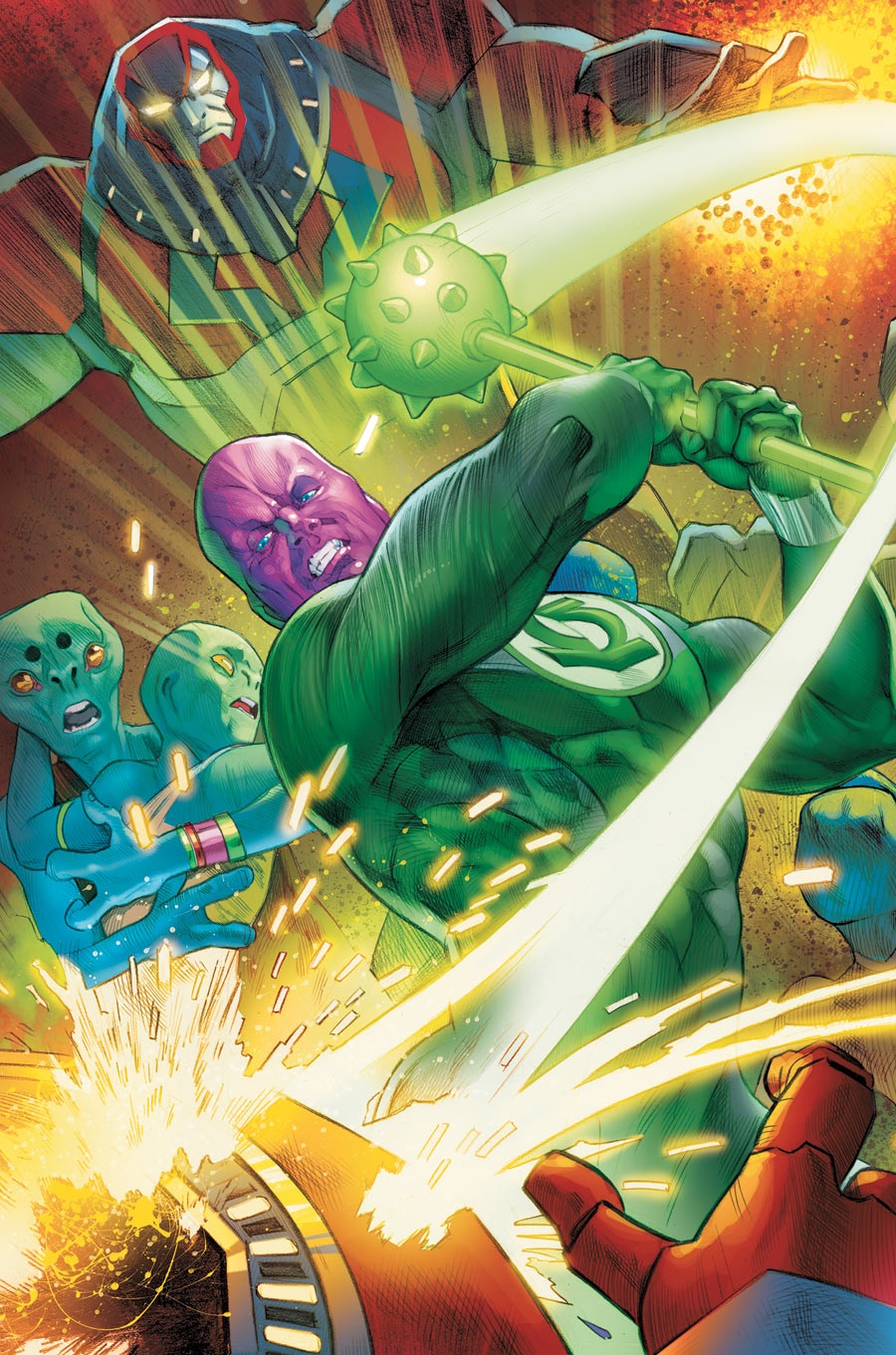
FLASHPOINT: ABIN SUR THE GREEN LANTERN #3
Writer: Adam SchlagmanArt: Robson Rocha & Felipe Massafera
Publisher: DC Comics
Reviewer: Optimous Douche
Rushed…hackneyed…nonsensical and shoe-horned. Yes, this is about as kind as I can get about this mini within a maxi.
I’m a huge proponent of FLASHPOINT. I’m still not sure how I feel about it being the catalyst that destroys 80 years of canon and serves as the bedrock for the new DC universe, but I will reserve that judgment until all is said and done. My point is, I don’t hate FLASHPOINT. Nor do I view the miniseries tie-ins as blatant cash grabs. Some titles like THE OUTSIDER and BATMAN have been damn enjoyable and truly enriched the story. However, there are others that beg the question whether they were really needed. ABIN SUR is one, and I will be using all of my will to forget it ever happened, especially this hot mess conclusion.
This is one time I’m not going to apologize for spoilers because I am doing all of you a service. I am your helmet on a stick, taking creative sniper fire straight into the cerebellum and eating the fiduciary losses as well. If anything you should all apologize to me.
Also understand that I’m biased. I was extremely disappointed with the end of BRIGHTEST DAY and its Hallmark Movie of the Week messaging that every sperm is sacred, we should all embrace life. You know what, until someone gives us proof that death is better we should all be embracing life regardless. So when Abin Sur dons a white ring at the end of this thing, you can appreciate why I threw up in my mouth a little.
So let’s start at the beginning. I actually enjoyed the first issue of the series. Abin Sur was Green Lantern of our sector, friends with Sinestro, actually Sinestro’s brother-in-law. How’s that for keeping it within the emerald family? And most importantly, he never really spent time on Earth. There are actually other planets in our sector. One wouldn’t think so reading a current Green Lantern title, but there are. Even though Sur’s sister was worm food, Sinestro had yet to go off the rails. So what makes him turn into the villain we all love to hate? A prophecy. The Blackest Flashpoint prophecy. All right, it was just the prophecy of Flashpoint, but you can’t blame me for getting mixed up in the head since, you know, the last biggest event was a prophecy as well. I haven’t heard of a universe being this preordained since I watched that reality show on Mormons. OK, shit, we have another prophecy, but at least we’ll get to see Hal Jordan and Abin Sur together when Abin is sent to Earth by the Guardians to look for the white light that will thwart the Blackest Brightest Flashpoint.
Shit…no Jordan, really. Yes, Jordan helps Abin after he crashes on Earth (why is Abin the only Green Lantern that uses a ship?), but Abin lives, so ring Nazi says “no ring for joo Hal Jordan.” Keep in mind these events, though, were really explored in Hal’s miniseries. Issue 2 was more Abin becoming a defender of Earth in our darkest time as the Atlanteans and Amazonians tear up the northern hemisphere. While I was starting to lose interest at this point, it all fit within the context of FLASHPOINT and there was nary a white light to be found, much to the Guardian’s bulbous headed chagrin.
Issue three, though, was a complete amalgamation of everything I hate. Sinestro seems to go off the deep end…because of a prophecy delivered to him by Atrocitus. Does this sound like the Sinestro we all know? Sinestro’s rage has always been cool, calm and collected. I understand this is a parallel to what we know, but he seriously goes Joker -tyle crazy, making him not Sinestro at all. Now things get really confusing: one minute we’re on Earth, the next we are on Oa, and they both look the same. Using the laziest convention available, we get to see omnipotent flashes of happenings from other FLASHPOINT events while Abin Sur is telepathically linked to the Guardians…or not…I’m not sure, I don’t know where the fuck anything was taking place. Of course, none of this is helped by the fact the artists shift hands at this point and the duties are carried forward by my neighbor’s three year old daughter. Seriously, the last half of the art in this book is almost laughable. I have never seen anything this poor come out of the big two. This isn’t even a stylistic critique, this is just plain terrible. Pacing, panels and rendering are simply shit. I’m closer to autistic than artistic and I would throw my pathetic hand scribbles in here first.
So now we have terrible art to back-up an editor that was asleep at the wheel. When Abin Sur says F the white light, the Guardians decide to expel him for the corps, but…wait for it…they decide to let him keep his ring until it powers down. Huh? That’s like me defaulting on my car payment and Hyundai letting me keep the car until it runs out of gas. Why would the Guardians do this when they clearly have the power to strip people of rings as they recently did with Hal Jordan? Why, God, why? The plot. Abin had to get back to Earth so he could have a peyote induced dream walk with his sister and then become the next White Lantern…setting us up for a White Lantern in FLASHPOINT.
I wish I could be clearer, but frankly the last moments of this book were a mess of confusion. So don’t shoot the messenger, kids. Simply shoot the last two issues of this mess with a flamethrower.
Optimous has successfully blackmailed fellow @$$Hole BottleImp into being his artist on Average Joe. Look for Imp's forced labor on Optimous brain child in mid-2011 from COM.X. Friend Optimous on FaceBook to get Average Joe updates and because ceiling cat says it's the right thing to do.
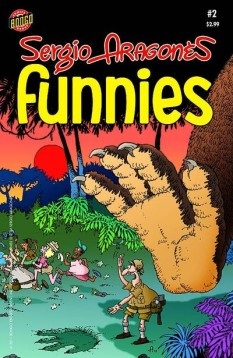
SERGIO ARAGONES' FUNNIES #2
Story & Art by Sergio AragonesPublisher: Bongo Comics
Reviewer: MajinFu
If you grew up reading MAD magazines like I did (usually while my parents were shopping at the market) then you’ve probably seen this kind of comics before. The stories lack the ties to pop culture inherent in MAD, or the lyrical barbarism of Groo, but it’s really all about giving a prolific artist a chance to give their unique spin on storytelling, and it’s a treat to read. Like the first issue, much of this comic is autobiographical. Sergio Aragonés (who will henceforth be referred to as SA) is obviously crafting a very personal comic, and the effect is heartwarming, even when he’s discussing the dilemma of printing letters in its opening pages. Comic creators encouraging a dialog with readers isn’t anything new but it’s always something I have enjoyed. It adds to the charm, even as these funnies bear their creator’s personal touch on their sleeve.
The first actual story features an alternative take on King Kong that is colorful and entertaining, even if the premise is a bit simple. My favorite parts were easily the silent one-page gags that were in black and white, which best showed SA’s cartooning talents. The middle part which details SA’s childhood career as an artist is humorous and inspiring for artists young and old. The story is a great highlight for SA’s skill for expressions and simple, clean layouts that still look very organic. This comic just has so much variety and good-natured humor that it’s easy to see this being enjoyed by both kids and adults. There are even a few puzzles to pore over, and every page (even the back cover) is smothered with art that is finely detailed, yet it breathes with a vigor and humor that is the creator’s trademark.
It’s always nice to see an enthusiastic creator getting to tell the stories that they want to tell, and it looks like Sergio Aragonés has just begun to create his own unique legacy in the FUNNIES. I look forward to reading the next issue, and sharing the ones I already have with friends and family.
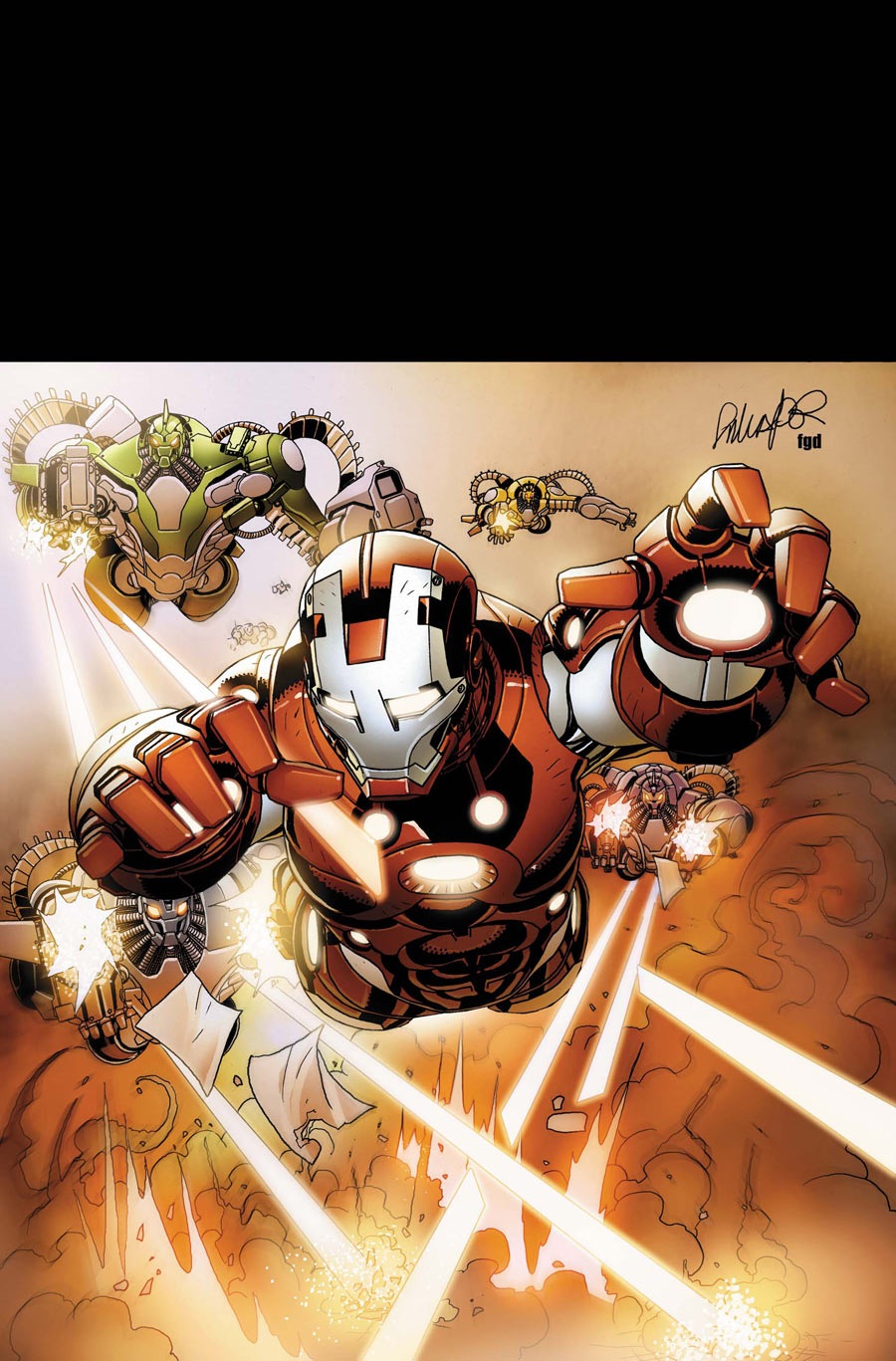
INVINCIBLE IRON MAN #507
Writer: Matt FractionArt: Salvador Larroca
Publisher: Marvel Comics
Reviewer: Henry Higgins is My Homeboy
Drunks And Dwarves
Regardless of your feelings towards the event as a whole, FEAR ITSELF has, at least to me, succeeded extremely well in terms of character. Thor, Loki, Steve Rogers, Ben Grimm, many established characters have gotten a new drive from the event. Tony Stark stands out, however, in terms of having the most interesting turns. The IRON MAN tie-in issues have maintained a certain drive and suspense, and this one continues on.
Writing: (4/5) The issue mostly focuses on two plots: Tony attempting to deal with being drunk while readying an arsenal for the heroes, and Pepper attempting to avoid both H.A.M.M.E.R. and Gray Gargoyle. Tony's plot remains the same as last issue, still attempting to build using the Asgardian metals. It doesn't change pace at all from the last issue, and while it's still a very intriguing place to take Tony, Fraction doesn't add much to it, save an assassination attempt on Tony that will of course fail. It's still interesting, but rather uneventful. Tony remains conflicted, but still with a smile plastered across him. It adds nothing really to the story, save for the revelation that the Extremis will serve a role in the new armor.
Pepper fares much better. Her battles with H.A.M.M.E.R., leading into a desperate escape from Gray Gargoyle, are crisp, flow with ease, and never lag. The short scenes between Sasha Hammer and Pepper are well written and tense, and are followed by a well written fight sequence. It ends with a climatic scene that plays well and interestingly. The tie-in maintains the flow and conflict from the main series, but it also keeps with a unique and thrilling story.
Art: (4/5) Larroca is a fantastic artist, and he keeps the book looking fantastic. The fight sequences flow beautifully, and convey a tremendous amount motion and movement. The brawl with Pepper turns into a chaotic chase, and it plays amazingly. His work on characters and their faces continues to be fairly hit or miss. It's stands out well sometimes (notably drunk Tony, who has a number of well done scenes), but others don't work as well. The H.A.M.M.E.R. agents differ, sometimes looking like painful drawings, others working considerably better.
Best Moment: The arrival of the Gray Gargoyle.
Worst Moment: A little bit of the art.
Overall: (4/5) Continuing a flawless record with this tie in, Iron Man maintains a solid run within the FEAR ITSELF event.
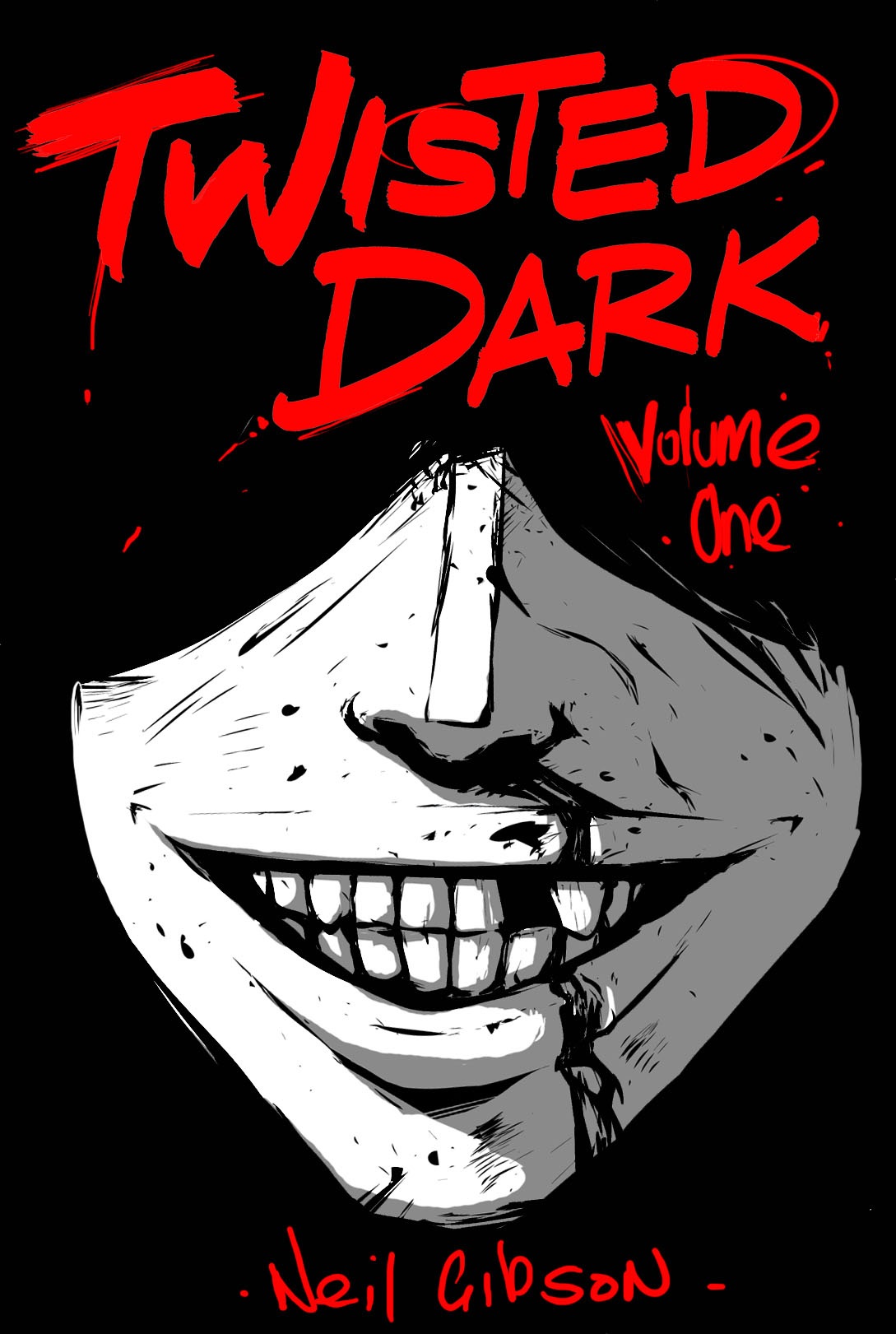
TWISTED DARK Vol.1
Writer: Neil GibsonArtists: Various
Publisher: Neil Gibson
Reviewer: Optimous Douche
Two days after finishing TWISTED DARK, the macabre vignettes that compile this horror show are still with me. Generally I hate horror, I find the characters insipid, and the gore doesn’t frighten me--it simply makes my stomach turn. Thankfully Gibson doesn’t write the traditional horror spoon-fed to us by Hollywood. TWISTED DARK is the horror of the soul casting a reflective light into the deep recesses that we keep hidden for the sake of a happy societal veneer.
What Gibson has created here is a marvel. Not only is TWISTED DARK the best self-published graphic novel I have EVER read, this is probably the best indie I have read this year and certainly affected me more than any book I picked up from the major publishers in many, many months. The fact that this is Gibson’s first work simply astounds me. TWISTED DARK is professionally put together with stories that not only adhere to Freytag’s pyramid, but outright covet it. In several pages I cared more about the characters in some of these stories than characters I have been reading for years in monthlies.
It’s generally very easy for me to pick out favorite stories in compilation books. I can’t do it with TWISTED DARK; each story builds off the last even though they are completely unrelated aside from the theme of “things will end badly.” A woodsman who traces the path his son took each day before the boy shot himself, a drug cartel story where the protagonist is morally right yet still ends up lying on a sheet of plastic with his limbs blown off, a woman who transcends her Munchhausen syndrome to her son when people no longer care about her inflicting pain on herself…that’s just a whisper of the darkness that lives inside these pages. For the deeper dive read on, but you will not be the same.
Each story is a surprise. Sometimes the surprises are the fact that you think things will turn out all right for the protagonist even though you have been bitch slapped with the evils of mankind in the prior story. Hell, even the entrance to the book sets a cheerful tone where Neil does a comparison to himself and another famous Gibson with a lighthearted checklist of how he is different than Mel. This lighthearted approach to opening makes the decent into darkness all that more abrupt and worthy of the journey. Each story in TWISTED DARK offers the same exhilarating decent into the abyss as a drop off of 90 degree rollercoaster rise, except in this case the track collides into a brick wall of human torment.
I’m going to try and pick favorites here since I know I’m dangerously approaching the red zone of reader attention with my word count, but make no mistake these are merely the stories that stuck with me the most — they are not by any means favorites.
Suicide: A typical chat room, a typical self-obsessed American not happy with all of the glories life has bestowed upon them in their big house and with their fancy computer. Artist Atula Siriwardance makes the chat room come alive during this first-person narrative of a person reaching out to the anonymous faces of the internet looking for some reason to go on. Typical stuff you would find in any twenty- or thirty-something that contemplates the meaninglessness of existence. BAM! The soulful eyes of a 10 year old are behind these cries for help. For anyone that wonders whether the internet has affected humanity, well there you go.
A Lighter Note: You got me with this one, Neil. When an Indian man seeks a better life through a work agency he finds that all is not the sunshine and roses promised to him before he leaves his country. This story tells the tale of Rajeev, a man who ends up in deplorable work conditions and rises (peacefully) against the man to win better working conditions and the adoration of his fellow workers. All ends well…Rajeev achieves his goals. Then in the last panel he wonders what he will do with his newfound power as exceptional artist Heru Djalal paints a wry smile across Rajeev’s face.
Windowpayne: My main reason for remembering this one is that this is the only story that infuses a little bit of sci-fi into TWISTED DARK. Set in 2022, a young man who was once a burn victim with the scars to prove it develops a type of glass that is not only load bearing, but it is infused with transparent circuitry that allows it to act as a television showing any scene imaginable. Gibson shows a world where houses become crystalline taking us out of the self-imposed caves we have built over the centuries. Again, the tale reeks of optimism for a brighter domestic tomorrow--that is, until we learn that this young genius can control all of the circuitry in the windows and short it out. The world will burn, one beautiful manufactured vista at a time.
That’s enough. To give away more would do no justice, not Gibson as creator or you as readers. TWISTED DARK is a book that simply demands to be read.
\ If art is truly a reflection of the artist, I would be afraid to ever be alone with Gibson. I’m sure the conversation would start with tons of laughs, but I would be greatly wary of the outcome.
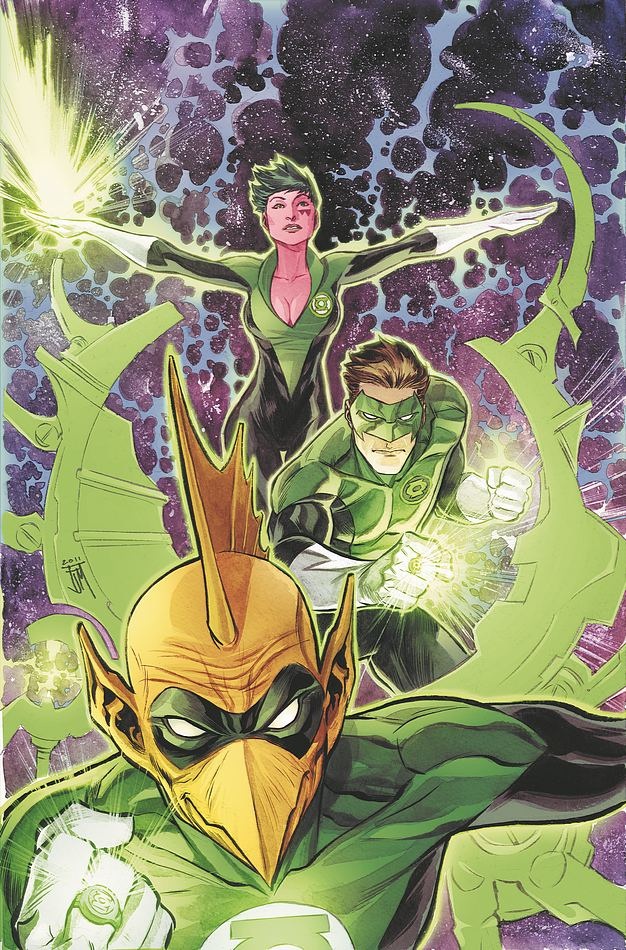
GREEN LANTERN CORPS #63
Writer: Scott KolinsArt: Scott Kolins, Daniel HDR, Freddie Williams II and Joe Prado
Publisher: DC Comics
Reviewer: The Writing Rambler
They always say all good things must come to an end and after 63 issues, as the main cover reminds us, it’s time to say goodbye to the GREEN LANTERN CORPS. This goodbye will be short-lived, of course, as most readers are fully aware GREEN LANTERN CORPS will continue in the new GREEN LANTERN CORPS #1 (currently scheduled for a September 21st release). Nonetheless, I enjoyed this issue as it continued to show how disheveled the Corps have become in the aftermath of the WAR OF THE GREEN LANTERNS and took time to remind us that despite the hard times there is still honor amongst the Corps.
Scott Kolins presents the reader with four different chapters showing some of the different ways the Corps are suffering in the wake of this past war. I actually enjoyed how this was handled for the most part. The way the stories are presented sets up some ideas for where the series may be headed in the relaunch and it does so without focusing on main characters like Hal or Sinestro. The fact that some of the lesser characters are given focus here is the high point of the issue and a good reminder that though most larger stories revolve around the four Earth Lanterns, there is a much bigger Corps who are being affected by these events. Probably the best of the four stories actually revolves around the idea that many of the Green Lanterns have reached a boiling point towards their disdain of the Earth Lanterns and are tired of them seemingly always being the center of the Corps’ problems. I’m hoping this idea is explored in depth once the relaunch happens as it could provide some great stories of conflict within the Corps.
The art in the issue is much like the story as it is divided into four unique chapters. Normally I’m not a fan of multiple artists handling one issue (as it can become a distraction) but it works here as we’re presented with each individual tale. All four artists hold their own in the book and I especially liked the combination of Freddie Williams II’s art matched with Kolins’ story about the anger towards the Earth Lanterns (which Kyle Rayner is forced to be the recipient of). I also loved the variant cover featuring Kyle looking like the toughest version of a Blue Lantern I’ve ever seen, though I must point out, at no point in this issue (or any of the relaunch cover previews for that matter) does Kyle become a Blue Lantern. In all honesty, it makes no sense as a variant to this issue but its artistic quality should still be commended.
As the issue ends, the reader is presented with the idea that despite all of these obstacles, true members of the Green Lantern Corps know their duty comes above all other things. Some may find the wrap up of the issue somewhat cheesy and forced (which I can understand to an extent) but I think the overall reminder that members of the Corps hold a high honor and take it very seriously despite their disagreements is a great way to end the 63 issue run. While I wouldn’t say this was the best possible way the series could have ended I do think it’s handled well enough to give proper closure to a solid book and bridge the gap for what’s to come.
You can follow The Writing Rambler on his blog here and follow on Twitter @Writing_Rambler !
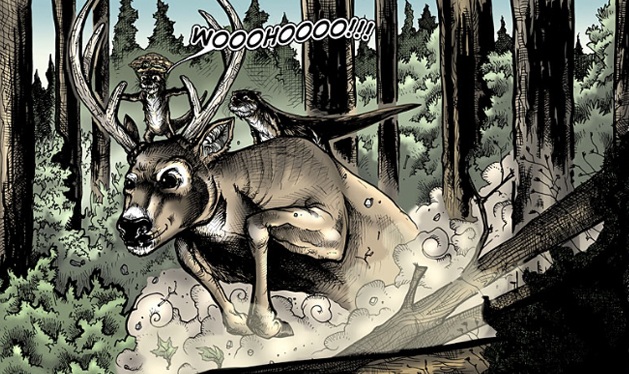
WAR OF THE WOODS Chapters 1-5
Writer: Matthew PetzArtist: Matthew Petz
Publisher: ComiXology
Reviewer: Lyzard
The first graphic novel I reviewed for Ain’t It Cool News was entitled THE BROADCAST. It had an interesting set up: what if one town truly believed that Orson Welles’ radio broadcast of H.G. Wells’ WAR OF THE WORLDS was real? The graphic novel could have been trite, but ended up showing a flair of originality. Not to discredit the creativity of THE BROADCAST, but the comic WAR OF THE WOODS also presents an interesting perspective on the work of H.G. Wells. What happens to the animals when the aliens land?
We’ve seen and read hundreds of alien invasion novels and films. There are obvious clichés to how humans react to such catastrophes. But to my knowledge, the fauna side has yet to be explored. Matthew Petz, both writer and artist, takes us into the New Jersey Pine Barrens to show us how Earth’s other inhabitants would handle an alien invasion.
The chapters are short, about ten pages per issue, and so far Petz is up to number five. Despite each being a short read, Petz has a strong handle on structure. He always leaves you with a cliffhanger that is quickly cleared up come the next issue, only to be followed by another cliffhanger. The pacing doesn’t drag; in fact, the story picks up momentum issue by issue.
The artwork is a bit static, especially in the faces of the animals. The otters rarely change expression, and when they do, it may just be an enlargement of the eyes. This, however, improves as the issues continue. As for the character design, the animals are cute, while the aliens are vicious. There is also another character, appearing at the end of issue number two, that leaps off the page.
What I enjoyed about the comic was the accuracy of the animal portrayals. Fauna do have a sixth sense for disaster, such as in the cases of earthquakes or tornados. They tend to run for cover before the humans notice a problem. Petz plays on this concept within the comic. He also takes associations tied to certain animals to characterize them, like having the owl be the wise one of the group and the turtle being the oldest.
The anthropomorphic animals seem to be doing much better at surviving than most humans do in disaster movies. Petz, similarly, is doing much better at the end of issue number five than he was in the beginning. There are some moments where you need to take a leap of faith, but if you are willing to read a comic about animals that can talk back and forth with aliens, I’m sure you can make such a jump.
Lyzard is actually Lyz Reblin, a senior screenwriting major with an English minor at Chapman University. Along with writing for AICN, she has been published twice on the subject of vampire films.
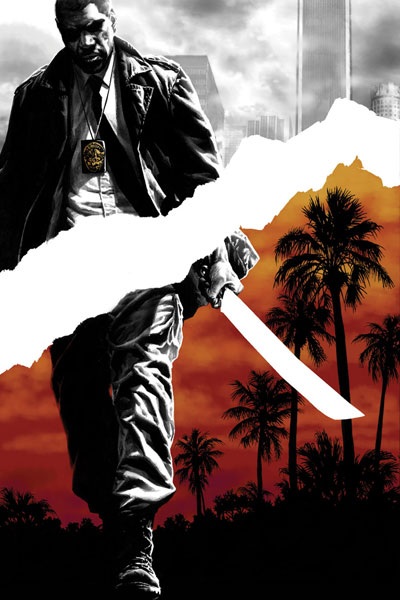
99 DAYS OGN
Writer: Matteo CasaliArtist: Kristian Donaldson
Publisher: DC Vertigo
Reviewer: Optimous Douche
On the surface this latest offering from the Vertigo Crime sub-brand lives in the gritty world of noir that fans have come to expect from these pint-sized black and whites. However, while the soul is noir the sensibilities are as modern as one would expect from a story that meticulously bounces back and forth between the Rwanda genocides of the early 90s to the gang strewn streets of modern Los Angeles. 99 DAYS also comes with a social conscience that begins as a whisper, but by the end roars across every page as the tables turn and then turn again towards the startling conclusion.
The tether between the worlds of 99 DAYS is L.A.P.D. Detective Antoine Davis. Davis not only lived through the Rwanda genocides in his early teens, but was also an active participant. Casali deftly uses this catalyst, never spilling all the beans in one money shot, but instead allowing each nefarious lesson learned in Rwanda to serve as the catalyst for the next chapter of the here and now. When a killer begins hacking apart the impoverished denizens of the ‘hood in LA, the killer’s choice of weapon, a machete, starts not only Davis’ investigation, but a remembrance of Davis’ own killings with the same weapon a decade prior. When this murderer goes after a woman that is sleeping with top chiefs in the Bloods and Crips, a war begins in the streets of LA, and it is up to Davis and his partner to solve the case before the city breaks out in all-out riots.
Davis, like many but not enough children of war, was adopted by a kindly couple that takes him in after America finally intervened in the warfare in Rwanda. Davis’ parents along with his partner, a spicy Latina (although I would never say that to her face) by the name of Valeria, are the only beams of light in what is otherwise an examination of the dark recesses of the soul. These pillars in Davis’ life were wonderful counterbalances to the ultra-violence that permeates the pages of this tale, especially Valeria. She serves as a friend and confidant to Davis that never falls into a Latina or a cop stereotype. She is the true modern woman, confident enough to let her sexuality shine through without ever having to sexualize herself to earn respect. I will say that at times I was confused by the sexual energy between Davis and Valeria. It seemed utterly unnecessary for the two to flirt with one another given the dangerous nature of their jobs and the fact that Valeria reiterates more times than not how happily married she is. It’s not that either crosses any lines, but they do talk about it, and it just seemed way out of context given the pounds of respect Casali infuses into each character and between one another.
The mystery and Antoine continue to unravel as the murders continue to heat up along with the gang warfare. Many reviewers took issue with Casali leveraging the voice of an omnipotent radio announcer to drive the events in Los Angeles forward, but I have to wholeheartedly disagree for one reason: Kristian Donaldson. Were these simply static shots of a political commentator sitting in a booth I would agree, but Donaldson’s pencils are kinetic from page one. Donaldson poses a true cinematographer’s eye, approaching every panel as a new challenge to present points of view that make the page move more than The Daily Prophet. Not only does Donaldson have a flair for the wide shot, the close-ups are just as imaginative. When most artists put half of a face in a panel it can usually be attributed to laziness. Donaldson uses half a face with purpose, because there is always something else in the scene of equal importance.
I would be lying if I said the reason for the murders was original. If you really want to know without reading the book you can find a hint in the plot for the movie “Batteries Not Included.” However, while the reason might not be original, the way justice is delivered is original and shocking. Also, this book isn’t about the mystery--it’s about the demons we all possess and whether we surmount or succumb to the weight they bare on our soul. Sometimes the answer is both.

LOOSE ENDS #2
Writer: Jason LatourArtist: Chris Brunner
Publisher: 12-Gauge
Reviewer: Lyzard
LOOSE ENDS is described as a southern crime romance, and the comic truly is, in that order. The dialogue is written phonetically southern and there is plenty of crime involving drugs and money, while the romance is not overpowering.
The first issue of LOOSE ENDS, while a good setup, does not prepare you for the darkness to come in issue number two. That’s where LOOSE ENDS pushes the gore and horror of the situation up a notch. You begin to understand how truly f*#&# up these characters are and the deep s*$& they are in.
LOOSE ENDS #2 starts with a flashback of what happened to Rej’s friend, Frankie. Due to some bad connections and bad deals, Frankie got shot in the face. Now Rej has to deal with his loose ends. Meanwhile, Sonny and Cheri are on the run, with Sonny still having to finish some business for Rej. Their backstory is also given in this issue.
The title becomes apropos in this book, where the audience begins to see how the characters are deeply connected to each other. There is much less action in this book than issue number one. It is more about character development and exposition, but this doesn’t make the issue boring. LOOSE ENDS #2 is all about raising the stakes, creating more tension.
When I first looked at LOOSE ENDS #1, the colors gave me a sense of “Grand Theft Auto: Vice City”. How ironic that the end of issue two places two of our characters in Florida. Due to the various flashbacks, there aren’t as many splashes of color as in the previous issue. But you don’t need a stark contrast of red to realize the grotesqueness of someone’s face shot off. Though sexual and violent, there is nothing truly pushing the envelope here. It is the same level of content one could see on cable right now.
If one can get past the southern accents, they’ll find quite the thriller. Everyone in the comic is flawed, has a past. Some worse than others, but they embroil the “good” ones in their problems. It is one of those series that you know that the last two issues will pack a punch. The first three issues are just the long fuse to the mountain of dynamite that is at the end of issue number four. Innocents will die, characters you learn to love will die, and most likely one of the bad guys will get away. Southern crime romances are gritty and raw, but also realistic. They show you that there is a dark underbelly to our world and that its pull on us is difficult to weaken.
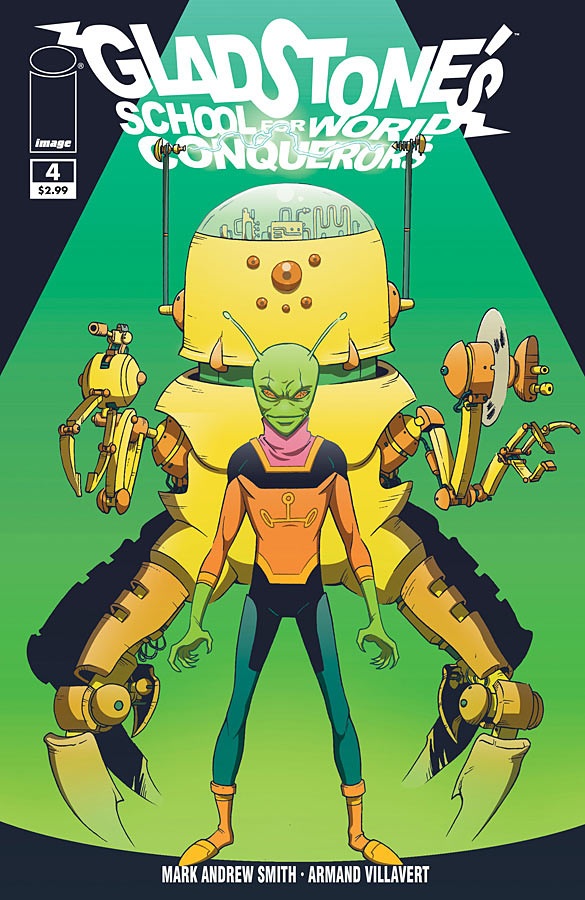 GLADSTONE’S SCHOOL FOR WORLD CONQUERORS #4
GLADSTONE’S SCHOOL FOR WORLD CONQUERORS #4Image Comics
This series got its hook in me with its last issue, when writer Mark Andrew Smith began to reveal the larger tapestry of the world occupied by his school for super-villains. Unfortunately, that new momentum grinds to a halt with this month’s installment, which feels very much like a placeholder issue. The plot isn’t horrible—basically, the reader sits in on a study session with the main cast—but it doesn’t really add much to what we’ve already seen. Plus, there’s one of those annoying moments when the writer decides to speak—nay, preach—to the reader through one of his characters, as Mummy Girl puts forth a defense of comic books as a legitimate art form. Yes, we get it, it’s hip and postmodern as these comic book characters discuss the very medium in which they exist, but we’ve gotten in before from other comics in deliveries both blatant and subtle. And on the artistic front, Armand Villavert’s determination to draw as little background detail as possible really grates on me with this issue, as the entire opening sequence takes place in some ill-defined, brightly glowing space that is indistinguishable from the previously-seen school classrooms, only to have it be revealed that the students are at Mummy Girl’s family home. I had a lot of high hopes for this comic after last month, but now… you’re back on probation, GLADSTONE’S. –BottleImp
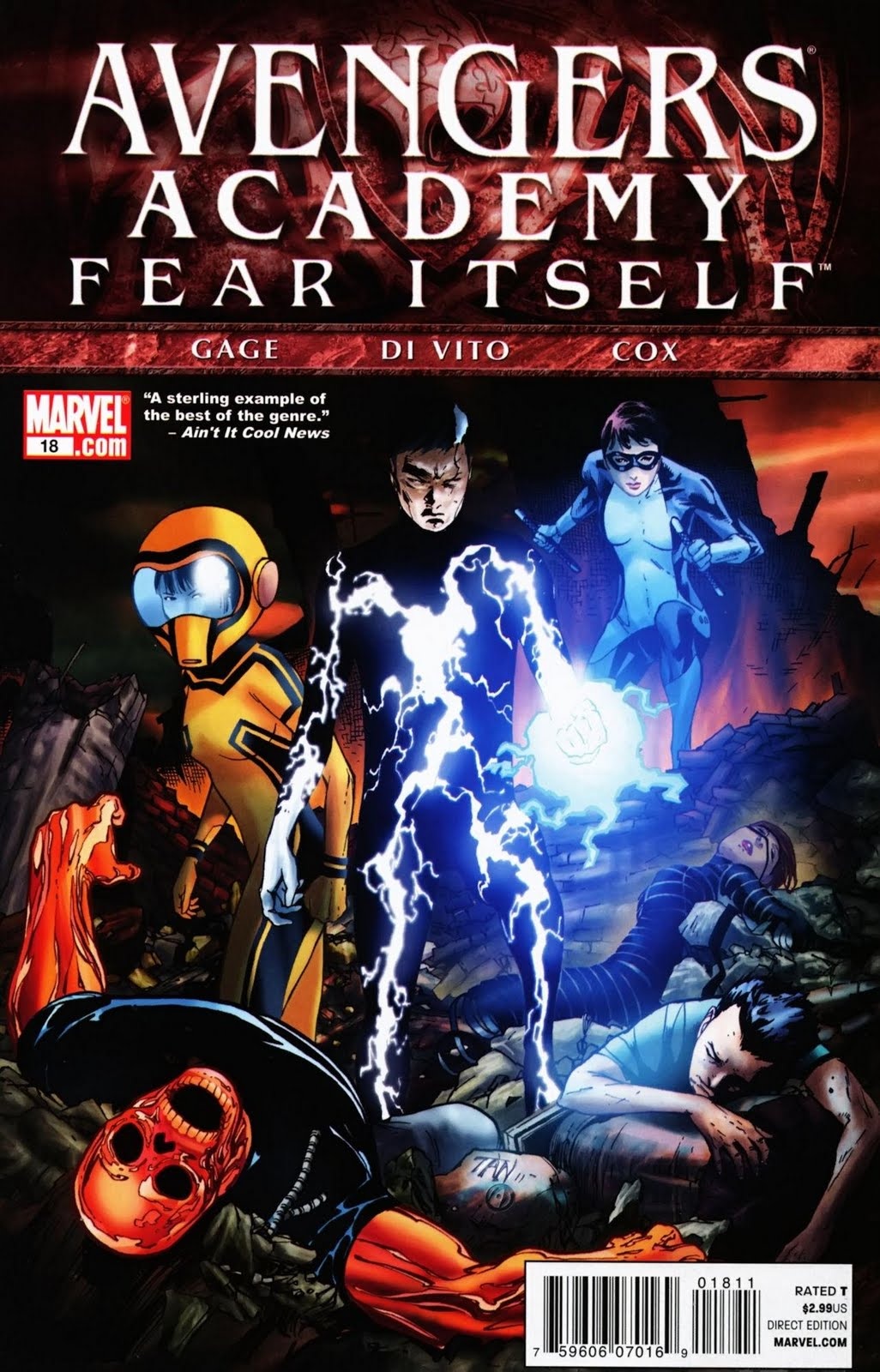 AVENGERS ACADEMY #18
AVENGERS ACADEMY #18Marvel Comics
I couldn’t care less about Marvel’s current FEAR ITSELF crossover, but I am glad to see that this title is dealing with the strictures of said crossover in the best way possible: by keeping the focus on the central cast and using the backdrop of FEAR ITSELF to develop the already-rich characters. As with previous story arcs, Christos Gage seems to relish throwing his troubled teenage superhumans into virtually unwinnable situations. This time around it’s the Norse God-possessed duo of Absorbing Man and Titania providing the menace, and credit must be given to Marvel’s crossover (as well as the talents of Gage and guest artist Andrea DiVito) for actually making these B-list villains a palpable threat. Still don’t like those glowing “Tron” lines though… I can’t wait until that annoying (and already stale) comic book costuming trend is dead and gone. -BottleImp
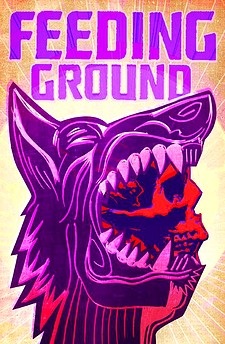 FEEDING GROUND #6
FEEDING GROUND #6Archaia
FEEDING GROUND comes to a close with this issue and it’s a doozy. There’s a whole lot of fantastic-looking werewolf action going on in this issue as the showdown at the border comes to a head between those guarding the Mexican American border, those who want to cross it, and the werewolves in between. This was a fantastic horror miniseries that shouldn’t be missed when collected in trade. The art is utterly unique and reflects Mexican culture, plus the fact that this is a flip book with one half in Mexican and the other in English means that you can enjoy this story in two languages (if you’re bi-lingual, that is). In Mexican or English, this is a pulse-pounding read which not only uses werewolves in a way I haven’t seen before, but carries with it a message that few comics are brave enough to address. Highly recommended. - Ambush Bug
Proofs, co-edits & common sense provided by Sleazy G

